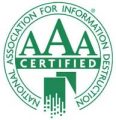A 7-part series presented as seven “strategies” that can be followed by any Texas School District to better manage their records in compliance with TSLAC requirements. The seven “strategies” include:
- Series Introduction & Make Sure All of Your TSLAC Documentation is Up to Date
- Identify Who Owns Responsibility for Which District Records
- Establish a Centralized Records Retention Center (RRC)
- Decide When Records Should be Processed and Moved to the RRC
- Routinely Process and Move Newly Inactive Records to the RRC
- Conduct Records Training for District Staff
- Stay Up to Date with TSLAC Changes & Series Conclusion
(Note: This series was originally published in the TASBO Report magazine and in subsequent editions in the online TASBO Business News email newsletter.)
INTRODUCTION
Whether you are a part of one of the largest Texas School Districts or a part of one of the smallest, you need to take control of your records—physical and electronic–and manage them through the appropriate retention life cycle in an efficient and compliant manner. Regardless of your size, there are some “common sense” strategies that can help all Districts achieve success with Records Management.
This is the first of a series of articles where we’ll be examining some of those strategies and providing some tips on topics ranging from “Keeping Up with TSLAC Requirements” to “Records Training for District Staff” to “Processing Records and Moving Inactive Records to your Records Retention Center.”
Strategy #1: Make Sure All of Your TSLAC Documentation is Up to Date.
The first step toward successfully managing your District’s records is to make sure all of your District’s information is up to date with the Texas State Library and Archives Commission (TSLAC). All Texas public school Districts are required by the Local Government Records Act to have three elements of compliance on file with the Texas State Library and Archives Commission1:
- Records Management Policy: You need to have developed a Records Management Policy for your District and have it on file with TSLAC. The Policy provides a definition of what is considered a “record”, declares records as public property, identifies a high-level policy, designates a Records Management Officer, and adopts TSLAC Records Control Schedules. (The Recommended Local Retention Schedulesfor various categories of District documents can be found on the TSLAC website: https://www.tsl.texas.gov/slrm/localretention.) This policy should be reviewed internally each year, and a current copy shared with TSLAC whenever it is revised. A sample Records Management Policy for school Districts—”Model Policy 4”—can be found on the TSLAC website: https://www.tsl.texas.gov/sites/default/files/public/tslac/slrm/recordspubs/forms/pm4.pdf
- Records Management Officer (RMO): TSLAC requires that each District designate a Records Management Officer to be responsible for overseeing the implementation of the District’s Records Management Policy. In addition, TSLAC wants to know who that person is and have contact information on file for them. Form SLR 504—Designation of Local Government Records Management Officer must be completed, signed, and submitted within 30 days of a change in the RMO. The position of the RMO filing form SLR 504 must match the position designated in the Policy. The SLR 504 form can be found on the TSLAC website: https://www.tsl.texas.gov/sites/default/files/public/tslac/slrm/pubs/SLR504.pdf
Note: Most Texas ISDs are Texas Association of School Boards (TASB) Policy subscribers. Subscriber school boards have adopted and approved CPC (LOCAL) Update 105 which designates the Superintendent as the RMO, but the Board can revise the Policy to designate any position as the RMO.
- Declaration of Compliance: You will also need to have a Declaration of Compliance with the records scheduling requirements on file. This document serves as formal acknowledgement that the District is aware of its Policy and that it is compliant with both that Policy and the recommended TSLAC local retention schedules. Form SLR 508—Declaration of Compliance with the Records Scheduling Requirement of the Local Government Act must be completed, signed, and submitted by the RMO. The form can be found on the TSLAC website: https://www.tsl.texas.gov/sites/default/files/public/tslac/slrm/pubs/SLR508.pdf
Additional Forms: Though not required to be filed with the state, TSLAC also provides two templates that should be kept in-house. The first—Declaration of Amendments to Local Government Retention Schedules—is used to record information about changes in local retention schedules. This is appropriate for when your District wants to keep records longer than the TSLAC recommended retention period.
The second—Records Disposition Log—is used to record the information about the destruction of records after their retention period has expired and they are obsolete. Templates for both of these forms are available on the TSLAC website: https://www.tsl.texas.gov/slrm/forms
TSLAC Analyst: While not required, it is of great benefit to know who your assigned TSLAC Analyst is, to get to know them, and to establish a rapport with them. They serve as a resource to answer questions and can provide valuable assistance if and when an issue arises. You can identify the Analyst for your area on the TSLAC Website: https://www.tsl.texas.gov/slrm/local/countylist.
In our next edition, we’ll discuss establishing roles and responsibilities for Records Management within the District.








